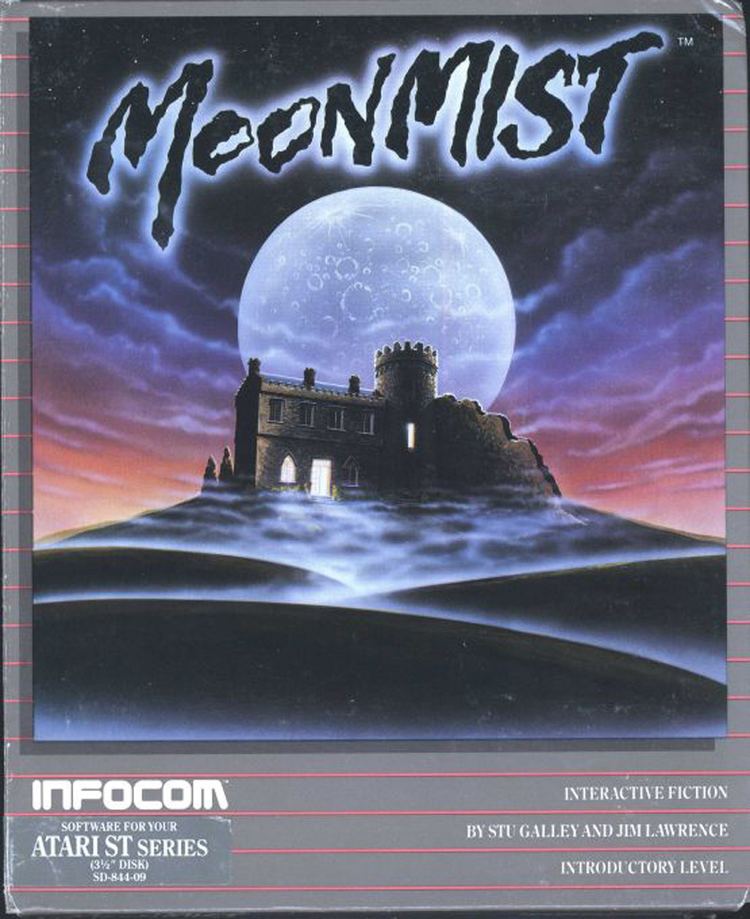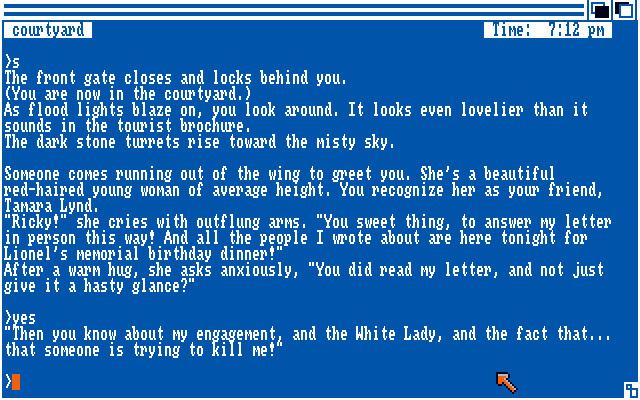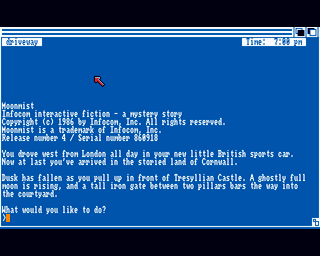8 /10 1 Votes
Engine ZIL Initial release date 1986 Designer Stu Galley Genre Interactive fiction | 4/5 My Abandonware Mode(s) Single player Developer Infocom Publisher Infocom | |||||||||||||||||||||||||||||||||
 | ||||||||||||||||||||||||||||||||||
Platforms DOS, MS-DOS, Commodore 64, Apple II Similar Infocom games, Adventure games | ||||||||||||||||||||||||||||||||||
Moonmist gameplay pc game 1986
Moonmist is an interactive fiction computer game written by Stu Galley and Jim Lawrence and published by Infocom in 1986. The game was released simultaneously for many platforms, including the IBM PC, Apple II, Amiga, Atari ST and Commodore 64. It is Infocom's twenty-second game.
Contents
- Moonmist gameplay pc game 1986
- Amiga ocs moonmist moon mist from lost treasures of infocom 1992activisionadisk 2 of 6wb adf
- Plot
- Gameplay
- Characters
- Feelies
- Remake
- Contemporary
- Retrospective
- References

Galley and Lawrence previously wrote Seastalker for Infocom.
Amiga ocs moonmist moon mist from lost treasures of infocom 1992activisionadisk 2 of 6wb adf
Plot

The player's character is a young detective, asked by friend Tamara Lynd to investigate her new home of Tresyllian Castle in Cornwall, England. Tamara has recently become engaged to the castle's lord, Jack Tresyllian. She was very happy until she began seeing what appeared to be The White Lady, a ghost who has allegedly haunted the castle for centuries. As if seeing a ghost wasn't nerve-racking enough, she's also begun to fear for her life. Is Tamara's imagination just overly excited from living in a large old castle, or is someone really trying to kill her? And if her life is in danger, is it from a ghost or someone using it as a disguise?
Gameplay

The actual game is divided into several quests depending on the player's answer to the question "what is your favorite color?" As such, the game contains a green (the easiest), blue, red, and yellow (the most difficult) quests, each with a separate criminal and treasure to locate. Interaction is made through the standard text commands typical of the genre.

Moonmist has a built-in timer. The game must be completed by 6:59 am the following day or the game ends without a resolution. It is also possible to die in a few rare instances, though the focus of the game remains on exploration and deduction.
Characters
Detective (Named by Player): A friend of Tamara Lynd and the persona assumed by the player.
Tamara Lynd: The detective's friend from back in the United States. She becomes affianced to Lord Jack Tresyllian and requests your help when her life is threatened on multiple occasions by the spectral "White Lady."
Lord Jack Tresyllian: The prim and proper lord of Tresyllian manor, engaged to Tamara Lynd. He is the nephew and heir of Lord Lionel Tresyllian, although it is revealed (albeit indirectly) that he was not the late-Lord's favorite choice as an heir.
Bolitho: The middle-aged butler of Tresyllian Castle who has served three generations of the family. He is at once reserved and obedient, yet a very reliable source of information about the castle, ghost, and other guests.
Dr. Nicholas Wendish: The grizzled yet highly intelligent head of a specialty medical clinic that treated Lord Jack's former fiancée, Deirdre Hallam, and her grandfather Mr. Poldark. Both died under questionable circumstances.
Sir Ian Fordyce: A member of Her Majesty's Coldstream Guard and a physically imposing figure. Little is revealed about Ian except that he is an archetypical English gentleman who would do anything that he perceived as his duty to the Crown.
Vivien Pentreath: An aloof, somewhat cold artist who is a friend of Lord Jack's and Deirdre's. This relationship has cooled, however, after Deirdre's apparent suicide; she thinks Jack heartless for proposing to Tamara so soon after Deirdre's death.
Montague Hyde: A successful antiquities dealer and former associate of Lord Lionel Tresyllian. As Lord Lionel was a famed explorer who brought back many rare artifacts from his travels, it was Montague Hyde who brokered the sale of those items to private buyers. He is searching for the last hidden artifact that Lord Lionel brought back with him to England before his death.
Lady Iris Vane: A London socialite who is at once beautiful and extremely flirtatious. Her association with the Tresyllian family is unclear, though she seems to have many powerful connections.
Lord Lionel Tresyllian: The late lord of Tresyllian Castle. In life he was a celebrated explorer who supported the family coffers through the sale of rare artifacts he would uncover during his travels. It is the anniversary of his birthday that the characters of Moonmist have gathered to celebrate. It is rumored that he had hidden one final object of great value somewhere in the castle before he died.
Deirdre Hallam: Lord Jack's former fiancée. Her life ended tragically when she allegedly jumped or fell into a deep well in the basement of Tresyllian Castle. Her body was never found.
Gladys: The maid of Tresyllian Castle. She never appears in the game except in the form of a letter she writes to Lord Jack announcing her resignation.
The White Lady: The legendary Ghost of Cornwall, the White Lady's origins are said to be that of the wife of a former Lord Tresyllian who walled her up alive for an imagined bout of infidelity. Her spirit is said to seek vengeance against all who dwell in the castle, with special attention to the Lady of the manor.
Feelies
To add to players' immersion in the story (as well as a means of copy protection), Infocom bundled extra items in with each game package. These objects were referred to as feelies. The feelies for Moonmist were:
Remake
In 1992, about six years after the original Moonmist, a remake of the game was developed and published by Japanese software development company SystemSoft for the NEC PC-9801, entitled Moonmist: Shiroki Kifujin no Nazo (
Contemporary
Compute! stated that Moonmist was a good introduction to Infocom adventures for newcomers, and an example for veterans of how their storytelling had improved from older games. However, Atari User expressed disappointment in the game's lack of depth and originality. While acknowledging that Moonmist had "deliberately been made simpler than the usual run of Infocom products", it noted that their earlier Wishbringer "was also a beginner's adventure but [..] offered yards more variety, entertainment, humour and challenge".
Retrospective
In his 2015 retrospective, historian Jimmy Maher criticized the game, stating that "Moonmist's variations simply aren’t varied enough ... After you’ve solved one of the cases, and thus know the steps you need to follow, solving the others is fairly trivial." He added that "Most damningly, Moonmist never even begins to succeed in giving you the feeling that you’re actually solving a mystery — the feeling that was so key to the appeal of Infocom’s original trilogy of mystery games", and concluded that "it's definitely one of the slighter works in the canon". It sold about 33,000 copies, fewer than Seastalker.
